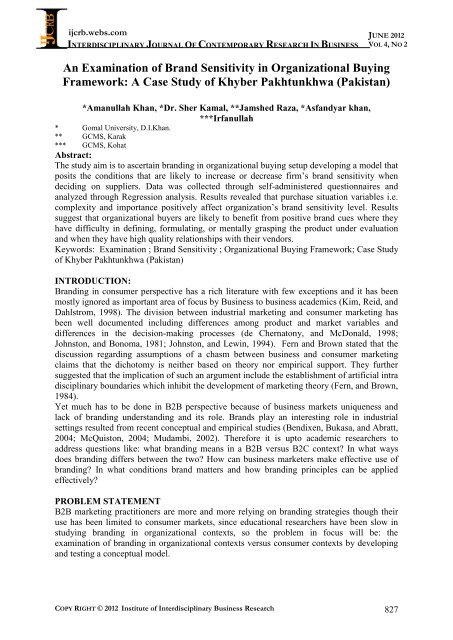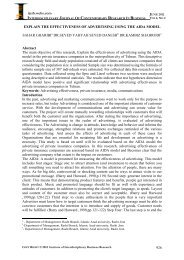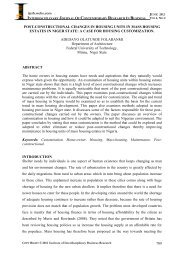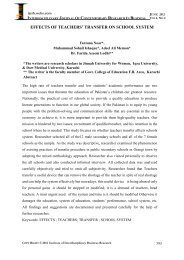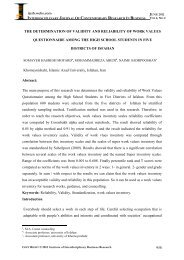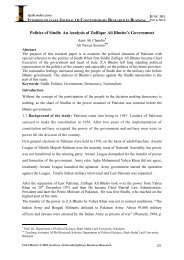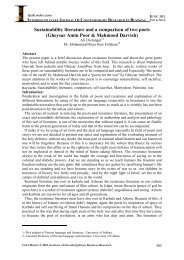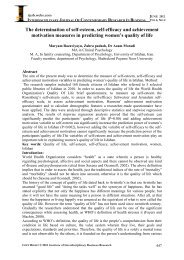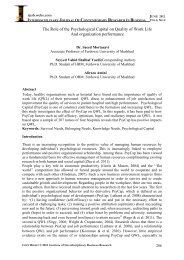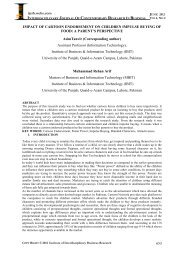An Examination of Brand Sensitivity in Organizational - journal ...
An Examination of Brand Sensitivity in Organizational - journal ...
An Examination of Brand Sensitivity in Organizational - journal ...
You also want an ePaper? Increase the reach of your titles
YUMPU automatically turns print PDFs into web optimized ePapers that Google loves.
ijcrb.webs.com<br />
INTERDISCIPLINARY JOURNAL OF CONTEMPORARY RESEARCH IN BUSINESS<br />
COPY RIGHT © 2012 Institute <strong>of</strong> Interdiscipl<strong>in</strong>ary Bus<strong>in</strong>ess Research<br />
JUNE 2012<br />
VOL 4, NO 2<br />
<strong>An</strong> <strong>Exam<strong>in</strong>ation</strong> <strong>of</strong> <strong>Brand</strong> <strong>Sensitivity</strong> <strong>in</strong> <strong>Organizational</strong> Buy<strong>in</strong>g<br />
Framework: A Case Study <strong>of</strong> Khyber Pakhtunkhwa (Pakistan)<br />
*Amanullah Khan, *Dr. Sher Kamal, **Jamshed Raza, *Asfandyar khan,<br />
***Irfanullah<br />
* Gomal University, D.I.Khan.<br />
** GCMS, Karak<br />
*** GCMS, Kohat<br />
Abstract:<br />
The study aim is to ascerta<strong>in</strong> brand<strong>in</strong>g <strong>in</strong> organizational buy<strong>in</strong>g setup develop<strong>in</strong>g a model that<br />
posits the conditions that are likely to <strong>in</strong>crease or decrease firm’s brand sensitivity when<br />
decid<strong>in</strong>g on suppliers. Data was collected through self-adm<strong>in</strong>istered questionnaires and<br />
analyzed through Regression analysis. Results revealed that purchase situation variables i.e.<br />
complexity and importance positively affect organization’s brand sensitivity level. Results<br />
suggest that organizational buyers are likely to benefit from positive brand cues where they<br />
have difficulty <strong>in</strong> def<strong>in</strong><strong>in</strong>g, formulat<strong>in</strong>g, or mentally grasp<strong>in</strong>g the product under evaluation<br />
and when they have high quality relationships with their vendors.<br />
Keywords: <strong>Exam<strong>in</strong>ation</strong> ; <strong>Brand</strong> <strong>Sensitivity</strong> ; <strong>Organizational</strong> Buy<strong>in</strong>g Framework; Case Study<br />
<strong>of</strong> Khyber Pakhtunkhwa (Pakistan)<br />
INTRODUCTION:<br />
<strong>Brand</strong><strong>in</strong>g <strong>in</strong> consumer perspective has a rich literature with few exceptions and it has been<br />
mostly ignored as important area <strong>of</strong> focus by Bus<strong>in</strong>ess to bus<strong>in</strong>ess academics (Kim, Reid, and<br />
Dahlstrom, 1998). The division between <strong>in</strong>dustrial market<strong>in</strong>g and consumer market<strong>in</strong>g has<br />
been well documented <strong>in</strong>clud<strong>in</strong>g differences among product and market variables and<br />
differences <strong>in</strong> the decision-mak<strong>in</strong>g processes (de Chernatony, and McDonald, 1998;<br />
Johnston, and Bonoma, 1981; Johnston, and Lew<strong>in</strong>, 1994). Fern and Brown stated that the<br />
discussion regard<strong>in</strong>g assumptions <strong>of</strong> a chasm between bus<strong>in</strong>ess and consumer market<strong>in</strong>g<br />
claims that the dichotomy is neither based on theory nor empirical support. They further<br />
suggested that the implication <strong>of</strong> such an argument <strong>in</strong>clude the establishment <strong>of</strong> artificial <strong>in</strong>tra<br />
discipl<strong>in</strong>ary boundaries which <strong>in</strong>hibit the development <strong>of</strong> market<strong>in</strong>g theory (Fern, and Brown,<br />
1984).<br />
Yet much has to be done <strong>in</strong> B2B perspective because <strong>of</strong> bus<strong>in</strong>ess markets uniqueness and<br />
lack <strong>of</strong> brand<strong>in</strong>g understand<strong>in</strong>g and its role. <strong>Brand</strong>s play an <strong>in</strong>terest<strong>in</strong>g role <strong>in</strong> <strong>in</strong>dustrial<br />
sett<strong>in</strong>gs resulted from recent conceptual and empirical studies (Bendixen, Bukasa, and Abratt,<br />
2004; McQuiston, 2004; Mudambi, 2002). Therefore it is upto academic researchers to<br />
address questions like: what brand<strong>in</strong>g means <strong>in</strong> a B2B versus B2C context? In what ways<br />
does brand<strong>in</strong>g differs between the two? How can bus<strong>in</strong>ess marketers make effective use <strong>of</strong><br />
brand<strong>in</strong>g? In what conditions brand matters and how brand<strong>in</strong>g pr<strong>in</strong>ciples can be applied<br />
effectively?<br />
PROBLEM STATEMENT<br />
B2B market<strong>in</strong>g practitioners are more and more rely<strong>in</strong>g on brand<strong>in</strong>g strategies though their<br />
use has been limited to consumer markets, s<strong>in</strong>ce educational researchers have been slow <strong>in</strong><br />
study<strong>in</strong>g brand<strong>in</strong>g <strong>in</strong> organizational contexts, so the problem <strong>in</strong> focus will be: the<br />
exam<strong>in</strong>ation <strong>of</strong> brand<strong>in</strong>g <strong>in</strong> organizational contexts versus consumer contexts by develop<strong>in</strong>g<br />
and test<strong>in</strong>g a conceptual model.<br />
827
ijcrb.webs.com<br />
INTERDISCIPLINARY JOURNAL OF CONTEMPORARY RESEARCH IN BUSINESS<br />
COPY RIGHT © 2012 Institute <strong>of</strong> Interdiscipl<strong>in</strong>ary Bus<strong>in</strong>ess Research<br />
JUNE 2012<br />
VOL 4, NO 2<br />
OBJECTIVES OF THE STUDY<br />
The thesis aim is to study brand sensitivity <strong>in</strong> organization’s buy<strong>in</strong>g situations with respect to<br />
Khyber Pakhtunkhwa. The <strong>in</strong>tention is:<br />
1. To study the effect <strong>of</strong> procedural control on brand sensitivity.<br />
2. To exam<strong>in</strong>e the impact <strong>of</strong> purchase importance on buy<strong>in</strong>g center’s level <strong>of</strong> brand<br />
sensitivity.<br />
3. To check the impact <strong>of</strong> purchase complexity on buy<strong>in</strong>g center’s level <strong>of</strong> brand<br />
sensitivity.<br />
4. To check the <strong>in</strong>fluence <strong>of</strong> departmental objectives on buy<strong>in</strong>g center’s level <strong>of</strong> brand<br />
sensitivity.<br />
5. To exam<strong>in</strong>e the impact <strong>of</strong> buyer-seller relationships on organization’s level <strong>of</strong> brand<br />
sensitivity.<br />
6. To check the effect <strong>of</strong> perceived quality <strong>in</strong>tangibility on organization’s level <strong>of</strong> brand<br />
sensitivity.<br />
7. To study the impact <strong>of</strong> <strong>in</strong>dividual risk attitude on organization’s level <strong>of</strong> brand<br />
sensitivity.<br />
RESEARCH HYPOTHESIS<br />
Keep<strong>in</strong>g <strong>in</strong> view the problem statement and research objectives, the hypothesis/questions for<br />
this study will be:<br />
H1.A buy<strong>in</strong>g center’s level <strong>of</strong> procedural control will directly impact its level <strong>of</strong> brand<br />
sensitivity. More specifically, procedural control will have a negative affect on brand<br />
sensitive.<br />
H2.Departmental objectives will directly <strong>in</strong>fluence a buy<strong>in</strong>g center’s level <strong>of</strong> brand<br />
sensitivity. More specifically, dom<strong>in</strong>ant functional areas that are quality oriented will be<br />
more brand sensitive than dom<strong>in</strong>ant functional areas that are cost-oriented.<br />
H3.High levels <strong>of</strong> purchase importance will positively impact a buy<strong>in</strong>g center’s level <strong>of</strong> brand<br />
sensitivity.<br />
H4.High levels <strong>of</strong> purchase complexity will positively impact a buy<strong>in</strong>g center’s level <strong>of</strong> brand<br />
sensitivity.<br />
H5.Buyer-seller relationships that are high <strong>in</strong> quality will negatively impact an organization’s<br />
level <strong>of</strong> brand sensitivity.<br />
H6.Higher levels <strong>of</strong> perceived product <strong>in</strong>tangibility will positively impact an organization’s<br />
level <strong>of</strong> brand sensitivity.<br />
H7.Individual risk attitude will moderate an organization’s level <strong>of</strong> brand sensitivity. More<br />
specifically, <strong>in</strong>dividual risk aversion will strengthen the relationship between buy<strong>in</strong>g<br />
center, purchase situation, and product/relationship variables and an organization’s level<br />
<strong>of</strong> brand sensitivity.<br />
APPROACH<br />
A survey based questionnaire was used for data collection on this topic. The methodology<br />
for survey was tested on buy<strong>in</strong>g center members (purchase managers/<strong>of</strong>ficers) to explore<br />
different facets <strong>of</strong> organizational buy<strong>in</strong>g behavior based on their expertise and experience <strong>in</strong><br />
B2B perspective.<br />
POPULATION AND SAMPLING<br />
The population <strong>of</strong> the research study consists <strong>of</strong> 1302 bus<strong>in</strong>esses / enterprises work<strong>in</strong>g <strong>in</strong><br />
different sectors <strong>of</strong> Peshawar (KPK) registered with SCCI a . A random sample <strong>of</strong> 90 buy<strong>in</strong>g<br />
a Sarhad chamber <strong>of</strong> commerce and <strong>in</strong>dustry<br />
828
ijcrb.webs.com<br />
INTERDISCIPLINARY JOURNAL OF CONTEMPORARY RESEARCH IN BUSINESS<br />
COPY RIGHT © 2012 Institute <strong>of</strong> Interdiscipl<strong>in</strong>ary Bus<strong>in</strong>ess Research<br />
JUNE 2012<br />
VOL 4, NO 2<br />
center members <strong>in</strong>clud<strong>in</strong>g purchas<strong>in</strong>g agents (male & female) that play an <strong>in</strong>fluential role <strong>in</strong><br />
purchase decisions to <strong>in</strong>vestigate various aspects <strong>of</strong> organizational buy<strong>in</strong>g behavior because<br />
<strong>of</strong> their knowledge and dist<strong>in</strong>ctive expertise. The <strong>in</strong>clusion <strong>of</strong> other buy<strong>in</strong>g center members<br />
provided a more complete assessment <strong>of</strong> organizational buy<strong>in</strong>g.<br />
Pilot study<br />
(n)<br />
Peshawar =<br />
25<br />
N SD 2 SE(E)<br />
= /√n<br />
Procedural control,<br />
purchase importance,<br />
product <strong>in</strong>tangibility<br />
E 2 Z@5% Computed<br />
Sample Sizes<br />
1302 0.74 0.5476 0.148 0.021904 1.96 90<br />
Formula used [ 2 /((E 2 /Z 2 )+( 2 /N))]<br />
EXTRACTED VARIABLES<br />
The follow<strong>in</strong>g variables were acknowledged from the literature review:<br />
<strong>Brand</strong> sensitivity is identified as dependent variable which is affected by three categories <strong>of</strong><br />
variables: buy<strong>in</strong>g center, purchase situation, and product/relationship. Each <strong>of</strong> these variables<br />
is proposed to be moderated by a buy<strong>in</strong>g center member’s <strong>in</strong>dividual risk attitude.<br />
THEORETICAL FRAMEWORK<br />
The variables <strong>of</strong> <strong>in</strong>terest <strong>in</strong> this study are: buy<strong>in</strong>g center, purchase situation,<br />
product/relationship, brand sensitivity, and <strong>in</strong>dividual risk attitude. In particular the buy<strong>in</strong>g<br />
center variables are procedural control and departmental objectives, the purchase situation<br />
variables are purchase importance and complexity, and the product/relationship variables are<br />
relationship quality and <strong>in</strong>tangibility. In this study seven po<strong>in</strong>t Liker-type scale is be<strong>in</strong>g used.<br />
Figure 1: Model identify<strong>in</strong>g the key variables and a theoretical framework<br />
Independent<br />
Variables<br />
Individual<br />
Risk Attitude<br />
Moderat<strong>in</strong>g<br />
Variables<br />
Dependent<br />
Variables<br />
<strong>Brand</strong> <strong>Sensitivity</strong><br />
DATA COLLECTION<br />
Quantitative data was collected through a self-adm<strong>in</strong>istered questionnaire. Data on brand<br />
sensitivity was collected by us<strong>in</strong>g mixed method procedures i.e. quantitative and qualitative<br />
methods. The sources used for collect<strong>in</strong>g secondary-data & primary-data were: pr<strong>in</strong>tedmaterials<br />
& books; <strong>journal</strong>s & newspapers; magaz<strong>in</strong>es & catalogues; field-studies &<br />
<strong>in</strong>terviews.<br />
829
ijcrb.webs.com<br />
INTERDISCIPLINARY JOURNAL OF CONTEMPORARY RESEARCH IN BUSINESS<br />
COPY RIGHT © 2012 Institute <strong>of</strong> Interdiscipl<strong>in</strong>ary Bus<strong>in</strong>ess Research<br />
JUNE 2012<br />
VOL 4, NO 2<br />
FINDINGS OF THE STUDY<br />
4.1 ANALYSIS OF HYPOTHESIS<br />
4.1.1 Regression <strong>An</strong>alysis<br />
In order to check the sensitivity level <strong>of</strong> bus<strong>in</strong>ess organisations with respect to purchas<strong>in</strong>g<br />
brands <strong>in</strong> the prov<strong>in</strong>ce <strong>of</strong> Khyber Pakhtunkhwa (Pakistan) regression analysis was used. The<br />
<strong>in</strong>tention <strong>in</strong> this study was to check the association between dependent variable (brand<br />
sensitivity) and <strong>in</strong>dependent variables (buy<strong>in</strong>g center, purchase situation and relationship<br />
quality and <strong>in</strong>tangibility) with moderat<strong>in</strong>g effect <strong>of</strong> <strong>in</strong>dividual risk attitude (TABLE 1-12).<br />
TABLE-1<br />
Regression Results:<br />
Procedural Control vs. <strong>Brand</strong> <strong>Sensitivity</strong><br />
Coefficients<br />
Model<br />
Unstandardized Coefficients<br />
Standardized<br />
Coefficients<br />
B Std. Error Beta<br />
T Sig.<br />
1 (Constant) 5.622 .257 21.859 .000<br />
Procedural Control .041 .058 .074 .695 .489<br />
a. Dependent Variable: <strong>Brand</strong> <strong>Sensitivity</strong><br />
Organisations hav<strong>in</strong>g brand sensitivity dist<strong>in</strong>ctiveness do not significantly practiced<br />
procedural control variable at level (0.05) with R 2 -value (0.005), b-value (0.074) and t-value<br />
(0.695). Hence Hypothesis-1 (H1) is not supported. Imply<strong>in</strong>g that buy<strong>in</strong>g center level <strong>of</strong><br />
procedural control has an <strong>in</strong>direct impact on brand sensitivity hence carries a positive effect.<br />
Model<br />
TABLE-2<br />
Regression Results:<br />
Department Objectives vs. <strong>Brand</strong> <strong>Sensitivity</strong><br />
Coefficients a<br />
Unstandardized Coefficients<br />
Standardized<br />
Coefficients<br />
B Std. Error Beta<br />
T Sig.<br />
1 (Constant) 5.600 .380 14.725 .000<br />
Department Objectives .058 .110 .056 .528 .599<br />
a. Dependent Variable: <strong>Brand</strong> <strong>Sensitivity</strong><br />
Organisations hav<strong>in</strong>g brand sensitivity features do not significantly accomplished Department<br />
Objectives at level (0.05) with R 2 -value (0.003), b-value (0.056) and t-value (0.528).<br />
Therefore hypotheses-2 is not supported, imply<strong>in</strong>g that the departmental objectives has<br />
<strong>in</strong>directly manipulated the buy<strong>in</strong>g centers level <strong>of</strong> brand sensitivity.<br />
TABLE-3<br />
Regression Results:<br />
Importance vs. <strong>Brand</strong> <strong>Sensitivity</strong><br />
Coefficients a<br />
Model<br />
Unstandardized Coefficients<br />
Standardized<br />
Coefficients<br />
B Std. Error Beta<br />
T Sig.<br />
1 (Constant) 6.764 .477 14.183 .000<br />
Importance -.189 .094 -.211 -2.022 .046<br />
a. Dependent Variable: <strong>Brand</strong> <strong>Sensitivity</strong><br />
830
ijcrb.webs.com<br />
INTERDISCIPLINARY JOURNAL OF CONTEMPORARY RESEARCH IN BUSINESS<br />
COPY RIGHT © 2012 Institute <strong>of</strong> Interdiscipl<strong>in</strong>ary Bus<strong>in</strong>ess Research<br />
JUNE 2012<br />
VOL 4, NO 2<br />
Organisations with brand sensitivity attributes significantly carried out importance at level<br />
(0.05) with R 2 -(0.044), b-value (-0.211) and t-value (-2.022). So hypothesis-3 (H3) is<br />
supported. <strong>An</strong>d hence purchase importance has positive effect on brand sensitivity level.<br />
Model<br />
TABLE-4<br />
Regression Results:<br />
Complexity vs. <strong>Brand</strong> <strong>Sensitivity</strong><br />
Coefficients a<br />
Unstandardized Coefficients<br />
Standardized<br />
Coefficients<br />
B Std. Error Beta<br />
T Sig.<br />
1 (Constant) 6.267 .237 26.470 .000<br />
Complexity -.120 .061 -.207 -1.980 .051<br />
a. Dependent Variable: <strong>Brand</strong> <strong>Sensitivity</strong><br />
Organisations with brand sensitivity characteristics significantly performed Complexity at<br />
level (0.05) with R 2- value (0.043), b-value (-0.207) and t-value (-1.980). Therefore<br />
hypothesis-4 (H4) is supported. <strong>An</strong>d as a result purchase complexity shows positive impact<br />
on brand sensitivity.<br />
TABLE-5<br />
Regression Results:<br />
Commitment, Trust and Satisfaction vs. <strong>Brand</strong> <strong>Sensitivity</strong><br />
Coefficients a<br />
Model<br />
Unstandardized Coefficients<br />
Standardized<br />
Coefficients<br />
B Std. Error Beta<br />
T Sig.<br />
1 (Constant) 7.350 1.216 6.043 .000<br />
Trust -.129 .197 -.069 -.655 .514<br />
Satisfaction -.265 .114 -.247 -2.328 .022<br />
Commitment .073 .126 .062 .580 .564<br />
a. Dependent Variable: <strong>Brand</strong> <strong>Sensitivity</strong><br />
Organisations with brand sensitivity characteristics do not significantly performed<br />
Relationship Qaulity at level (0.05) at all. Trust variable at significance level (0.514) with R 2 -<br />
value (0.072), b-value (-0.069) & t-value (-0.655). Satisfaction variable at significance level<br />
(0.022), significantly implies with dependent variable, with b-value (-0.247) and t-value (-<br />
2.328). Like trust, commitment fraction <strong>of</strong> the relationship quality does not significantly<br />
practice the dependent variable with b-value (0.062), t-value (0.580) and significance level<br />
(0.564). So hypothesis 5 is not supported suggest<strong>in</strong>g that relationship quality has a negative<br />
effect on brand sensitivity.<br />
TABLE-6<br />
Regression Results:<br />
Intangibility vs. <strong>Brand</strong> <strong>Sensitivity</strong><br />
Coefficients a<br />
Model<br />
Unstandardized Coefficients<br />
Standardized<br />
Coefficients<br />
B Std. Error Beta<br />
T Sig.<br />
1 (Constant) 4.828 .880 5.485 .000<br />
Intangibility .188 .171 .117 1.105 .272<br />
831
ijcrb.webs.com<br />
INTERDISCIPLINARY JOURNAL OF CONTEMPORARY RESEARCH IN BUSINESS<br />
Model<br />
Coefficients a<br />
Unstandardized Coefficients<br />
COPY RIGHT © 2012 Institute <strong>of</strong> Interdiscipl<strong>in</strong>ary Bus<strong>in</strong>ess Research<br />
Standardized<br />
Coefficients<br />
B Std. Error Beta<br />
T Sig.<br />
1 (Constant) 4.828 .880 5.485 .000<br />
Intangibility .188 .171 .117 1.105 .272<br />
a. Dependent Variable: <strong>Brand</strong> <strong>Sensitivity</strong><br />
JUNE 2012<br />
VOL 4, NO 2<br />
Organisations with brand sensitivity characteristics do not significantly performed<br />
<strong>in</strong>tangibility at level (0.05) with R 2 -value (0.014), b-value (0.117) and t-value (1.105).<br />
Therefore hypothesis 6 (H6) is not supported. So product <strong>in</strong>tangibility shows a negative<br />
impact on brand sensitivity.<br />
TABLE-7<br />
Regression Results:<br />
Individual Risk and Procedural Control vs. <strong>Brand</strong> <strong>Sensitivity</strong><br />
Coefficients a<br />
Model<br />
Unstandardized Coefficients<br />
Standardized<br />
Coefficients<br />
B Std. Error Beta<br />
T Sig.<br />
1 (Constant) 5.153 .694 7.425 .000<br />
Procedural Control .038 .059 .070 .653 .516<br />
Individual Risk .099 .136 .078 .727 .469<br />
a. Dependent Variable: <strong>Brand</strong> <strong>Sensitivity</strong><br />
Organisations with brand sensitivity characteristics observed no significant <strong>in</strong>fluence on<br />
procedural control accompanied by <strong>in</strong>dividual risk <strong>in</strong>dicated with R 2 –value (0.011), b-values<br />
(0.070) & (0.078) and t-values (0.653) & (0.727) respectively. So as a result procedural<br />
control fraction regard<strong>in</strong>g hypothesis 7 with <strong>in</strong>terven<strong>in</strong>g effect <strong>of</strong> <strong>in</strong>dividual risk is not<br />
supported.<br />
TABLE-8<br />
Regression Results:<br />
Individual Risk and Department Objectives vs. <strong>Brand</strong> <strong>Sensitivity</strong><br />
Coefficients a<br />
Model<br />
Unstandardized Coefficients<br />
Standardized<br />
Coefficients<br />
B Std. Error Beta<br />
T Sig.<br />
1 (Constant) 5.040 .789 6.386 .000<br />
Department Objectives .065 .110 .063 .591 .556<br />
Individual Risk .110 .136 .087 .809 .421<br />
a. Dependent Variable: <strong>Brand</strong> <strong>Sensitivity</strong><br />
Those organisations hav<strong>in</strong>g brand sensitivity characteristics observed no significant <strong>in</strong>fluence<br />
on Departmental Objectives and <strong>in</strong>dividual risk <strong>in</strong>dicated by R 2 -values (0.011), b-values<br />
(0.063) & (0.078) and t-values (0.591) & (0.087) respectively. Hence as a result departmental<br />
objective regard<strong>in</strong>g hypothesis 7 with moderat<strong>in</strong>g effect <strong>of</strong> <strong>in</strong>dividual risk is not<br />
substantiated.<br />
832
ijcrb.webs.com<br />
INTERDISCIPLINARY JOURNAL OF CONTEMPORARY RESEARCH IN BUSINESS<br />
Model<br />
TABLE-9<br />
Regression Results:<br />
Individual Risk and Importance vs. <strong>Brand</strong> <strong>Sensitivity</strong><br />
Coefficients a<br />
Unstandardized Coefficients<br />
COPY RIGHT © 2012 Institute <strong>of</strong> Interdiscipl<strong>in</strong>ary Bus<strong>in</strong>ess Research<br />
Standardized<br />
Coefficients<br />
B Std. Error Beta<br />
T Sig.<br />
1 (Constant) 6.111 .741 8.245 .000<br />
Importance -.208 .095 -.232 -2.193 .031<br />
Individual Risk .154 .134 .121 1.148 .254<br />
a. Dependent Variable: <strong>Brand</strong> <strong>Sensitivity</strong><br />
JUNE 2012<br />
VOL 4, NO 2<br />
Organisations with brand sensitivity characteristics observed significant <strong>in</strong>fluence on<br />
importance at level (0.05) with R 2 -value (0.059), b-value (– 0.232) and t-value (0.031).<br />
Organisations hav<strong>in</strong>g brand sensitivity characteristics observed no significant <strong>in</strong>fluence on<br />
<strong>in</strong>dividual risk at level (0.05) with R 2 -value (0.059), b-value (0.121) and t-value (1.148). <strong>An</strong>d<br />
as a result importance fraction regard<strong>in</strong>g hypothesis-7 (H7) with mediat<strong>in</strong>g effect <strong>of</strong><br />
<strong>in</strong>dividual risk is not supported.<br />
TABLE-10<br />
Regression Results:<br />
Individual Risk and Complexity vs. <strong>Brand</strong> <strong>Sensitivity</strong><br />
Coefficients a<br />
Model<br />
Unstandardized Coefficients<br />
Standardized<br />
Coefficients<br />
B Std. Error Beta<br />
T Sig.<br />
1 (Constant) 5.872 .713 8.239 .000<br />
Complexity -.116 .061 -.200 -1.906 .060<br />
Individual Risk .079 .134 .062 .588 .558<br />
a. Dependent Variable: <strong>Brand</strong> <strong>Sensitivity</strong><br />
Organisations with brand sensitivity characteristics observed significant <strong>in</strong>fluence on<br />
Complexity and <strong>in</strong>dividual risk <strong>in</strong>dicated by R 2 -values (0.046), b-values (-0.200) & (0.062)<br />
and t-values (-1.906) & (0.588) respectively. <strong>An</strong>d as a result complexity fraction regard<strong>in</strong>g<br />
hypothesis-7 with <strong>in</strong>terven<strong>in</strong>g effect <strong>of</strong> <strong>in</strong>dividual risk is not supported.<br />
TABLE-11<br />
Regression Results:<br />
Individual Risk, Commitment, Trust and Satisfaction vs. <strong>Brand</strong> <strong>Sensitivity</strong><br />
Coefficients a<br />
Model<br />
Unstandardized Coefficients<br />
Standardized<br />
Coefficients<br />
B Std. Error Beta<br />
T Sig.<br />
1 (Constant) 6.979 1.332 5.238 .000<br />
Trust -.140 .198 -.075 -.707 .481<br />
Satisfaction -.263 .114 -.245 -2.306 .024<br />
Commitment .066 .127 .056 .520 .604<br />
Individual Risk .093 .134 .073 .693 .490<br />
a. Dependent Variable: <strong>Brand</strong> <strong>Sensitivity</strong><br />
833
ijcrb.webs.com<br />
INTERDISCIPLINARY JOURNAL OF CONTEMPORARY RESEARCH IN BUSINESS<br />
COPY RIGHT © 2012 Institute <strong>of</strong> Interdiscipl<strong>in</strong>ary Bus<strong>in</strong>ess Research<br />
JUNE 2012<br />
VOL 4, NO 2<br />
Organisations with characteristics <strong>of</strong> brand sensitivity do not significantly performed<br />
Relationship Quality at level (0.05) at all. Trust variable at level (0.481) don’t perform<br />
significantly with R 2 -value (0.077), b-value (-0.075) and t-value (-0.707), whereas<br />
satisfaction variable at level (0.024) perform significantly with dependent variable, with bvalue<br />
(-0.245) and t-value (-2.306). Like trust, commitment fraction <strong>of</strong> the relationship<br />
quality does not significantly practice the dependent variable with b-value (0.056), t-value<br />
(0.520) and at significance level (0.604). Like wise <strong>in</strong>dividual risk do not practice<br />
significantly with b-value (0.073), t-value (0.693) and significant level (0.490). As a result<br />
quality fraction regard<strong>in</strong>g hypothesis-7 (H7) with mediat<strong>in</strong>g effect <strong>of</strong> <strong>in</strong>dividual risk is not<br />
supported.<br />
Model<br />
TABLE-12<br />
Regression Results:<br />
Individual Risk and Intangibility vs. <strong>Brand</strong> <strong>Sensitivity</strong><br />
Coefficients a<br />
Unstandardized Coefficients<br />
Standardized<br />
Coefficients<br />
B Std. Error Beta<br />
T Sig.<br />
1 (Constant) 4.248 1.127 3.770 .000<br />
Intangibility .196 .171 .122 1.145 .256<br />
Individual Risk .112 .135 .088 .826 .411<br />
a. Dependent Variable: <strong>Brand</strong> <strong>Sensitivity</strong><br />
Organisations with brand sensitivity characteristics observed no significant <strong>in</strong>fluence on<br />
Intangibility and <strong>in</strong>dividual risk <strong>in</strong>dicated by R 2 -value (0.021), b-values (0.122) & (0.088)<br />
and t-values (1.145) & (0.826) respectively. Hence as a result <strong>in</strong>tangibility regard<strong>in</strong>g<br />
hypothesis-7 (H7) with moderat<strong>in</strong>g effect <strong>of</strong> <strong>in</strong>dividual risk is not supported.<br />
By conclud<strong>in</strong>g the <strong>in</strong>terven<strong>in</strong>g effect <strong>of</strong> <strong>in</strong>dividual risk, organizations with brand sensitivity<br />
attributes observed no significant <strong>in</strong>fluence <strong>of</strong> <strong>in</strong>dependent variables i.e. procedural control,<br />
departmental objectives, purchase importance and complexity, relationship quality and<br />
<strong>in</strong>tangibility respectively. Hence <strong>in</strong>dependent variables regard<strong>in</strong>g hypothesis 7 with<br />
moderat<strong>in</strong>g effect is not supported at all.<br />
CONCLUSION<br />
The concept <strong>of</strong> brand sensitivity was orig<strong>in</strong>ated <strong>in</strong> consumer literature and related to an<br />
<strong>in</strong>dividual’s personality characteristic. This study adapted the orig<strong>in</strong>al measure <strong>of</strong> brand<br />
sensitivity and applied it <strong>in</strong> an organizational buy<strong>in</strong>g sett<strong>in</strong>g. It appears to be versatile enough<br />
to capture the attitudes <strong>of</strong> a group <strong>of</strong> bus<strong>in</strong>ess managers charged with mak<strong>in</strong>g a product<br />
selection. The study provides valuable <strong>in</strong>formation to bus<strong>in</strong>ess organisations work<strong>in</strong>g <strong>in</strong><br />
different sectors <strong>of</strong> Khyber Pakhtunkhwa (Pakistan) by <strong>in</strong>dicat<strong>in</strong>g that purchase situation is a<br />
theoretical concept and is critical for understand<strong>in</strong>g the role <strong>of</strong> brand<strong>in</strong>g <strong>in</strong> the organizational<br />
buy<strong>in</strong>g process.<br />
It posits that purchase situation variables i.e. purchase importance and complexity has a<br />
positive impact on organisation’s buy<strong>in</strong>g centre level <strong>of</strong> brand sensitivity by signify<strong>in</strong>g that<br />
bus<strong>in</strong>esses work<strong>in</strong>g <strong>in</strong> this area must take <strong>in</strong>to account the importance <strong>of</strong> purchase situation<br />
when formulat<strong>in</strong>g brand<strong>in</strong>g strategies with respect to bus<strong>in</strong>ess environment <strong>in</strong> which they are<br />
work<strong>in</strong>g. There is a need for recognition to measure the variation <strong>in</strong> brand importance from<br />
one buyer to another buyer <strong>in</strong>troduc<strong>in</strong>g the concept <strong>of</strong> brand sensitivity as a means <strong>of</strong><br />
compar<strong>in</strong>g branded products with un-branded ones (Kapferer, and Laurent, 1988).<br />
834
ijcrb.webs.com<br />
INTERDISCIPLINARY JOURNAL OF CONTEMPORARY RESEARCH IN BUSINESS<br />
COPY RIGHT © 2012 Institute <strong>of</strong> Interdiscipl<strong>in</strong>ary Bus<strong>in</strong>ess Research<br />
JUNE 2012<br />
VOL 4, NO 2<br />
S<strong>in</strong>ce buy<strong>in</strong>g units are dynamic & fluid and their brand sensitivity levels depend on a variety<br />
<strong>of</strong> personal and contextual variables, <strong>in</strong>clud<strong>in</strong>g their perceptions <strong>of</strong> risk, the <strong>in</strong>tangibility <strong>of</strong> a<br />
product, level <strong>of</strong> relationship quality with a vendor and complexity and importance <strong>of</strong> the<br />
brand. By tak<strong>in</strong>g these <strong>in</strong>to account bus<strong>in</strong>ess firms can successfully make their way towards<br />
prosperity by formulat<strong>in</strong>g acceptable bus<strong>in</strong>ess strategies.<br />
835
ijcrb.webs.com<br />
INTERDISCIPLINARY JOURNAL OF CONTEMPORARY RESEARCH IN BUSINESS<br />
COPY RIGHT © 2012 Institute <strong>of</strong> Interdiscipl<strong>in</strong>ary Bus<strong>in</strong>ess Research<br />
JUNE 2012<br />
VOL 4, NO 2<br />
REFERENCES<br />
Bendixen, M. Bukasa, K. A., & Abratt, R. (2004). <strong>Brand</strong> Equity <strong>in</strong> the Bus<strong>in</strong>ess-to-Bus<strong>in</strong>ess<br />
Market. Industrial Market<strong>in</strong>g Management, 33, 371-80<br />
de Chernatony, L., & McDonald, M. (1998). Creat<strong>in</strong>g Powerful <strong>Brand</strong>s <strong>in</strong> Consumer,<br />
Service, and Industrial Markets, 2nd ed. Oxford, England: Butterworth He<strong>in</strong>em<br />
Kim, J., Reid D. A., Plank, R. E., & Dahlstrom, R. (1998). Exam<strong>in</strong><strong>in</strong>g the Role <strong>of</strong> <strong>Brand</strong><br />
Equity <strong>in</strong> Bus<strong>in</strong>ess Markets: A Model, Research Propositions and Managerial Implications.<br />
Journal <strong>of</strong> Bus<strong>in</strong>ess-to-Bus<strong>in</strong>ess Market<strong>in</strong>g, 5 (3), 65-89.s<br />
Johnston, W. J., & Bonoma, T, V. (1981), "The Buy<strong>in</strong>g Center: Structure and Interaction<br />
Patterns," Journal <strong>of</strong> Market<strong>in</strong>g, 45, 143-156.<br />
Johnston, W. J., & Lew<strong>in</strong>, J. E. (1994), “A Review and Integration <strong>of</strong> Research on<br />
<strong>Organizational</strong> Buy<strong>in</strong>g Behavior,” In Work<strong>in</strong>g Paper Series, Report No. 94-111.<br />
Cambridge, MA, Market<strong>in</strong>g Science Institute.<br />
Fern, E. F., & Brown, J. R. (1984). The Industrial/Consumer Market<strong>in</strong>g Dichotomy: A Case<br />
<strong>of</strong> Insufficient Justification. Journal <strong>of</strong> Market<strong>in</strong>g, 48, 68-77.<br />
s<br />
McQuiston, D. H. (2004). Successful <strong>Brand</strong><strong>in</strong>g <strong>of</strong> a Commodity Product: The Case <strong>of</strong> RAEX<br />
LASER Steel. Industrial Market<strong>in</strong>g Management, 33, 345-54.<br />
Mudambi, S. M. (2002). <strong>Brand</strong><strong>in</strong>g Importance <strong>in</strong> Bus<strong>in</strong>ess-to-Bus<strong>in</strong>ess Markets: Three Buyer<br />
Clusters. Industrial Market<strong>in</strong>g Management, 31, 525-33.<br />
Kapferer, J.N., & Laurent, G. (1988). Consumer <strong>Brand</strong> <strong>Sensitivity</strong>: A Key to Measur<strong>in</strong>g and<br />
Manag<strong>in</strong>g <strong>Brand</strong> Equity. In Def<strong>in</strong><strong>in</strong>g, Measur<strong>in</strong>g and Manag<strong>in</strong>g <strong>Brand</strong> Equity. Ed. L.<br />
Leuthesser. Cambridge, MA: Market<strong>in</strong>g Science Institute, 12-15.<br />
836


